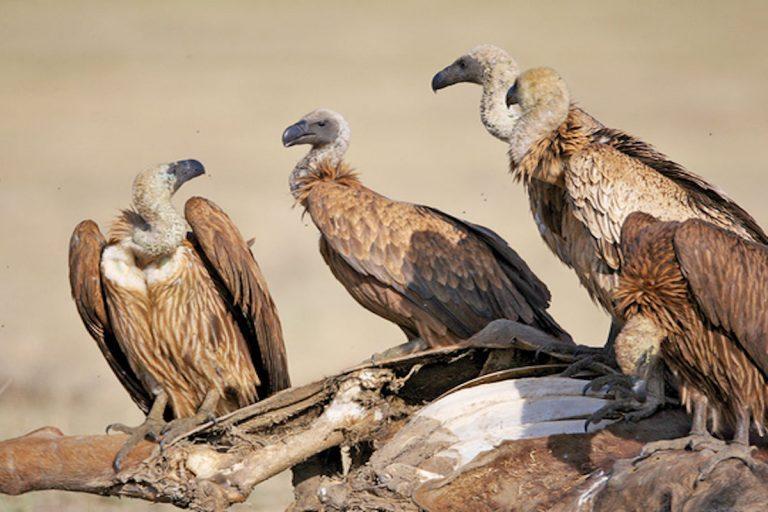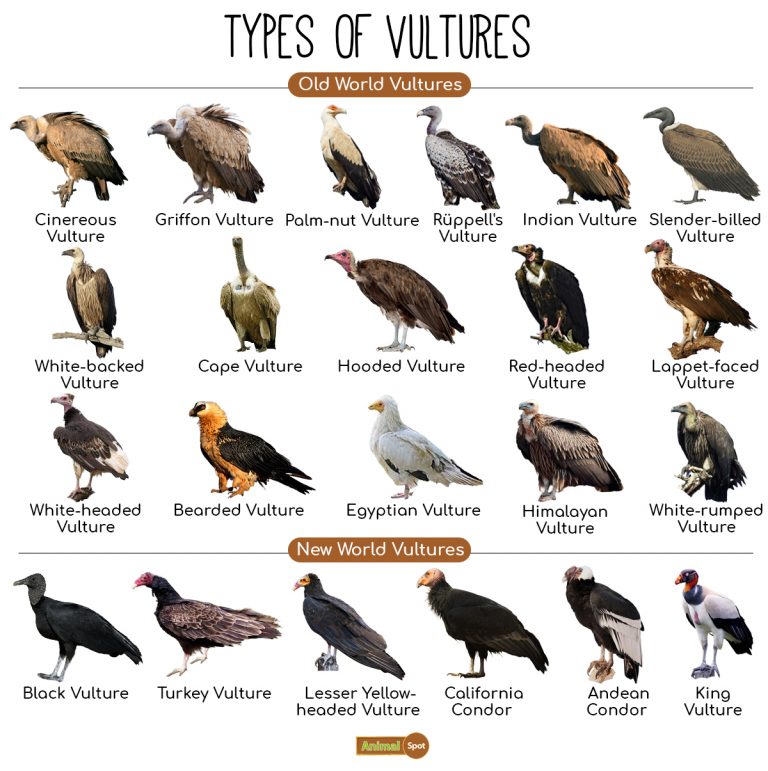VULTURE: 15 Fun Facts to Know About the Scavenging Bird of Prey

Did you know that vultures as scavengers help remove bacteria from the environment, and that the mountain-dwelling bearded vulture is the only vertebrate that specialize in eating only bones?
A vulture is a bird of prey that scavenges on carrion. There are 23 extant species of vulture (including Condors). A particular characteristic of many vultures is a bald, unfeathered head. This bare skin is thought to keep the head clean when feeding, and also plays an important role in thermoregulation. Here are some facts to know about the scavenging animal:
FACT 1: There are 16 living species of Old World vultures, native to Europe, Africa, and Asia; while New World vultures are restricted to North and South America and consist of seven identified species, all belonging to the Cathartidae family.
FACT 2: Vultures have been observed to hunch their bodies and tuck in their heads in the cold, and open their wings and stretch their necks in the heat. They also urinate on themselves as a means of cooling their bodies; the uric acid kills bacteria accumulated from walking through carcasses, and also acts as evaporative cooling.
FACT 3: A group of vultures in flight is called a 'kettle', while the term 'committee' refers to a group of vultures resting on the ground or in trees. A group of vultures that are feeding is termed a 'wake'.
FACT 4: In myth and culture, vulture is depicted as the ancient Egyptian art, Nekhbet, a mythological goddess and patron of both the city of Nekheb and Upper Egypt. Many Great Royal Wives wore vulture crowns - a symbol of protection from the goddess Nekhbet.
FACT 5: Ancient Egyptians also believed that all vultures were female and were spontaneously born from eggs without the intervention of a male, and therefore linked the birds to purity and motherhood, but also the eternal cycle of death and rebirth for their ability to transform the "death" they feed on – i.e. carrion and waste – into life.
FACT 6: Still on myths, in Pre-Columbian times, vultures were appreciated as extraordinary beings and had high iconographic status. They appear in many Mesoamerican myths, legends, and fables from civilizations such as the Maya and Aztecs, some depicting them negatively, others positively. The Aztec vulture vessel at the new Pre-Columbian Mesoamerican Pottery Gallery.

FACT 7: Vultures are scavengers, meaning that they eat dead animals. Outside of the oceans, vultures are the only known obligate scavengers. They rarely attack healthy animals, but may kill the wounded or sick. When a carcass has too thick a hide for its beak to open, it waits for a larger scavenger to eat first. Vast numbers have been seen upon battlefields. They gorge themselves when prey is abundant, until their crops bulge, and sit, sleepy or half torpid, to digest their food.
FACT 8: Vultures do not carry food to their young in their talons but disgorge it from their crops. The mountain-dwelling bearded vulture is the only vertebrate to specialize in eating bones; it carries bones to the nest for the young, and hunts some live prey.
FACT 9: Vultures are of great value as scavengers, especially in hot regions. Vulture stomach acid is exceptionally corrosive (pH=1.0), allowing them to safely digest putrid carcasses infected with botulinum toxin, hog cholera bacteria, and anthrax bacteria that would be lethal to other scavengers and help remove bacteria from the environment.
FACT 10: New World vultures often vomit when threatened or approached. Contrary to some accounts, they do not "projectile vomit" on their attacker in defence, but to lighten their stomach load to ease take-off. The vomited meal residue may distract a predator, allowing the bird to escape.
FACT 11: In various regions of Africa, the dynamic interplay of vultures and predators such as lions, cheetahs, hyenas, and jackals significantly influences the continent's food web. These avian scavengers actively engage in competition with these predatory animals for sustenance, meticulously tracking their hunting activities.
FACT 12: Traditionally, vultures are known to bide their time, patiently observing from a distance or high in the sky as predators bring down their prey and commence feeding. Once these formidable predators have satiated their hunger and moved away from their kills, the vultures swoop in, making the most of the leftovers. New research has revealed that these birds can, in addition to sight, respond to auditory cues indicative of potential foraging opportunities.
FACT 13: Still on feeding, interaction between vultures and predators is not strictly sequential or one-sided. Vultures, being opportunistic creatures, will often engage in risky behavior if a prime opportunity arises. Sometimes, when the predator numbers are low or distracted, these large birds might move in earlier, attempting to snatch morsels from the kill before the predators have fully vacated the scene. This daring strategy, while high-risk, underscores the fierce competition and survival instincts prevalent in the harsh realities of the African wild.
FACT 14: New World vultures and condors found in warm and temperate areas of the Americas belong to the family Cathartidae. Recent DNA evidence suggests that they should be included within order Accipitriformes along with birds of prey including hawks, eagles, and Old World vultures. Several species have a good sense of smell, unusual for raptors, and are able to smell dead animals from great heights, up to a mile away. The Old World vultures found in Africa, Asia, and Europe belong to the family Accipitridae, which also includes eagles, kites, buzzards, and hawks. Old World vultures find carcasses exclusively by sight.
Source: Wikipedia
#penglobalfactfile #vulture


_1755775186.jpg)
